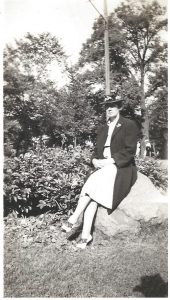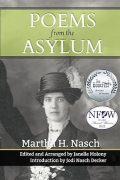Behind the Scenes: Writing Martha’s Story By Jodi Decker
Behind the Scenes: Writing Martha’s Story
By Jodi Decker

Jodi Decker in St. Paul
Sometimes the source of a story idea is in your DNA—literally. When my daughter and I embarked on writing Poems From the Asylum, about our great-grandmother and grandmother Martha Gruening Nasch, respectively, it sent us on a writing journey through genealogy, family history, and historical research to find the truth and set the record straight on her life story specifically, and the stigma of mental illness and treatment in general.
As family historians, we combed through journals, photos, court records, family trees, maps, census records, history books, newspaper reports, and interviewed museum docents, medical practitioners, and descendants of Martha’s neighbors.
The background of Martha Gruening Nasch’s incredible history began with her inherited poetry journal, passed down by my dad. Martha had written over 80 poems while confined to the St. Peter State Hospital for the Insane in the 1930’s, in St. Peter, Minnesota, for 7 years.
Written in pencil, in elegant cursive in a simple green school notebook, her poetry documented her observations, emotions, treatment, and lived experiences in the institution. Martha had been committed due to two suicide attempts, after disturbing claims that she couldn’t eat, drink, or sleep.
A mysterious surgery in 1927 seemed to provoke her downward spiral in physical and mental health. Poems From the Asylum delves into the themes of trauma, betrayal, family secrets, mental illness and treatment, recovery, poetry analysis, and sensationalistic journalism. Martha’s experiences, upon her release, were published in over 90 U.S. newspaper and Time magazine, 1934.
One of the initial considerations in writing her story was to identify our own biases as her descendants. The temptation to slant the story as my grandmother as a victim of her times, or her alleged philandering husband, doesn’t do justice to the complexities of mental health treatment, or lack of, during that time period, not to mention social class and overt and covert anti-German immigrant discrimination after WWI.
We had to consider multiple perspectives, when possible, to ensure that our conclusions were based on documented research where known. Where records simply didn’t exist, we suggested cultural and historical suppositions relevant to that era, or we allowed for the reader to reach their own conclusions. We fact-checked, we revised, and we solicited feedback from beta-readers.

Martha in St. Paul
Another part of the writing process was working collaboratively. We brought different ages and viewpoints to the material. As the writing evolved, we served as each other’s editors, not only for proofreading, but to ensure that the tone of the story remained seamless and consistent throughout. At times, we disagreed about interpreting Martha’s work. Was she a reliable narrator, considering her various ailments, was her husband Louis Jr. really the “bad guy” in this story, and could we give a fair and nuanced presentation of their marital woes, knowing there’s always two sides to the story?
Whether writing about real people or characters, showing the balance of positive and negative attributes provides more context, and it attempts at getting to the truth of the matter. As one maxim finds, there’s your truth, my truth, and the real truth.
Once the book was published, and even before then, there’s the entire business end to manage as well. My daughter is the business maven. This includes administering the Facebook page Seven Years Insane, overseeing the publishing and marketing of the book, eliciting and sharing reviews, and submitting the book for contest entries and awards, of which there have been several.
Free publicity includes writing press releases, granting podcast and newspaper interviews, and doing book fairs and book talks. Our networking efforts have included interfacing with bookstores, libraries, and history museums. This is a continual process, even as new endeavors and book projects are evolving. As a content editor, I create updated blog articles for the webpage, on history topics, mental health treatment, or additional photos or stories about Martha’s life.
Writing Martha’s story was never anticipated to be a “best seller,” as the topic of insanity and insane asylums are relatively unique topics. However, we believe it is a timeless story in terms of historical significance, not only as a narrative biography of one woman’s story, but as an expose on mental illness and treatment during the 1930’s, as told by a patient.
Her descendants wanted to preserve her legacy, and, through her published poems, let her words speak for herself and for others who couldn’t speak up for themselves during this time period.
Poems From the Asylum is available on Amazon, Barnes&Noble.com, and Kindle.
—
Jodi Decker is a college professor, family historian, and freelance writer. She and her daughter Janelle Molony are co-authors of Poems From the Asylum. Decker is also a content writer for the Facebook page Seven Years Insane.
POEMS FROM THE ASYLUM
 After noticing something strange from a secret medical procedure in 1927, St. Paul, Minnesota, Martha Nasch’s doctor claimed she just had a “case of nerves.” With a signature from her adulterous husband, Martha was committed against her will to the asylum. She spent nearly seven years in the Minnesota hospital during the Great Depression and tried to escape twice. Martha’s poems from behind bars include shocking eyewitness accounts of patient treatment and a long-suffering adoration for her only child, now being raised alone by her deceiving spouse.
After noticing something strange from a secret medical procedure in 1927, St. Paul, Minnesota, Martha Nasch’s doctor claimed she just had a “case of nerves.” With a signature from her adulterous husband, Martha was committed against her will to the asylum. She spent nearly seven years in the Minnesota hospital during the Great Depression and tried to escape twice. Martha’s poems from behind bars include shocking eyewitness accounts of patient treatment and a long-suffering adoration for her only child, now being raised alone by her deceiving spouse.
When not a soul believed Martha’s story, she sought an explanation for her mysterious condition that led her to a spiritual answer for the mystifying curse. Would her findings make her a metaphysical guru of the Breatharian lifestyle, or would she become the laughingstock of her Depression-era family?
Poems from the Asylum is a biography and complete anthology of harrowing and insightful poems written by Martha Hedwig Nasch, patient-inmate #20864 at the St. Peter State Hospital for the Insane. Editing and arrangement by Martha’s great-granddaughter, Janelle Molony, with an introduction by Jodi Nasch Decker, granddaughter and family historian. More than fifty photographs and illustrations are included with the historical research that accompanies this beautiful collection of poems.
BUY HERE
Category: Contemporary Women Writers, On Writing






























